EISENHOWER TO CUT GERMANY IN MIDDLE
SHAEF HQ, Reims, France · March 28, 1945
On this date in 1945 Supreme Allied Commander Gen. Dwight D. Eisenhower telegrammed Soviet leader Joseph Stalin that he proposed, after encircling Germany’s Ruhr district, to advance on an west-east axis through the center of Germany to the Upper Elbe River, 50 miles from Berlin, there to await the arrival of the Red Army. Eisenhower’s strategy was to cut Germany in half, separate the northern defenders from the southern, then focus his main forces on the supposed “National Redoubt” in the Alps, the rumored holdout for Adolf Hitler and his Nazi fanatics until new German secret weapons or a split in the Allied coalition came to their rescue. (The alpine redoubt was a myth originating with U.S. diplomats, picked up by the news media, and cleverly promoted by Joseph Goebbels, Nazi Minister of Propaganda, who appreciated its nuisance value in the Allies’ war strategizing sessions.)
British Field Marshal Bernard Law Montgomery, commander of nearly a third of the Allied army, believed Eisenhower was making a mistake. British Prime Minister Winston Churchill was upset that Eisenhower was prepared to leave the capital and epicenter of the Third Reich to the Soviets, and urged him to “shake hands” with the Soviets as far east as possible. This fateful decision was one of Eisenhower’s most controversial but it was in keeping with high-level agreements made months before.
As early as January 1944, the European Advisory Commission (EAC), which was charged with allocating zones of occupation to the three victorious powers (U.S., Britain, and the Soviet Union), endorsed a plan along lines suggested by the British: Berlin would fall within the Soviet occupation zone. In September 1944, at the Second Quebec (Canada) Conference, the heads of the two Western powers, President Franklin D. Roosevelt and Churchill, discussed the plan.
By the time FDR and Churchill were en route to the Big Three conference at the Crimean resort of Yalta in the Soviet Union (February 4–11, 1945), most of the details had been nailed down, including joint occupation of Berlin. Stalin accepted the EAC recommendations at Yalta, and the creation of military zones of occupation was announced at the close of the conference. Eisenhower, schooled in a tradition that military commanders should leave politics to civil authorities, was not distracted by the criticism of his stop order, and made for the Elbe River, meeting elements of the Red Army at Torgau on April 25, 1945.
Well-Publicized “Handshake of Torgau” on the Elbe River, April 25–26, 1945, Symbolized Defeat of Nazi Germany
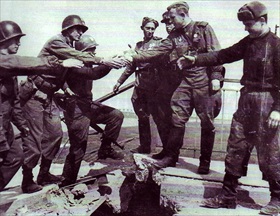 | 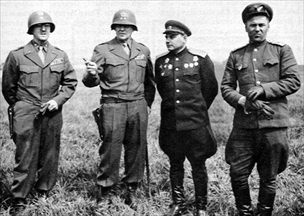 |
Left: This photo of GIs meeting Soviet soldiers on the Elbe is one of the two most famous photographs of World War II; the other was the flag-raising on Iwo Jima in the Pacific. On April 26, 1945, after photographing U.S. and Soviet generals and VIPs at the scene of the Torgau, Germany, historic linkup the day before, International News war correspondent Allan Jackson decided to take a picture of soldiers from the two sides shaking hands. He quickly gathered sightseeing American and Soviet soldiers and posed them, taking several pictures that became well known and symbolic of the two great powers meeting at the Elbe River. A bronze bas-relief panel depicting the Torgau Handshake is on the right-side wall (toward the Atlantic Arch) at the World War II Memorial in Washington, D.C.
![]()
Right: Two U.S. officers from Gen. Courtney Hodges’ First U.S. Army and two Soviet officers from Maj. Gen. Vladimir Rusakov’s 58th Guards Rifle Division survey the scene at Torgau. The town on the east bank of the Elbe River lay 33 miles northeast of Leipzig.
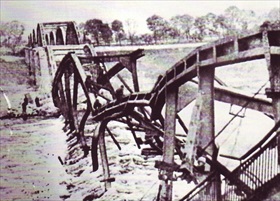 | 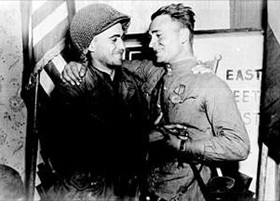 |
Left: Second Lt. William Robertson and Pfc. Frank Huff of the 69th Infantry Division crawl across the skeleton of the blasted bridge over the Elbe River (the two seen here in the “V” of the bridge) to Torgau on the east bank to meet Soviets Lt. Alexander Silvashko and Sgt. Nikolai Andrejew, 58th Guards Rifle Division, on April 25, 1945.
![]()
Right: Robertson and Silvashko pose on April 26, 1945, in front of a sign that reads East Meets West, symbolizing the historic linkup of Soviet and American armies near Torgau.
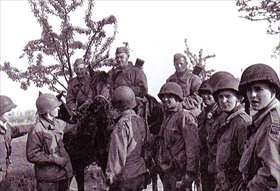 | 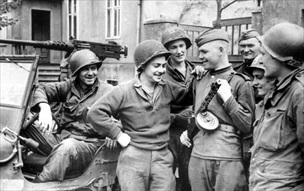 |
Left: Maj. Fred Craig’s patrol, one of three patrols of the 69th Infantry Division, meets a Soviet cavalry unit south of Torgau on April 25, 1945.
![]()
Right: A Soviet soldier holding a machine gun converses with GIs milling around a jeep in Torgau.
Silent Film Showing Historic Linkup of Soviet and American Troops at Torgau, April 25–26, 1945
![]()

 History buffs, there is good news! The Daily Chronicles of World War II is now available as an ebook for $4.99 on Amazon.com. Containing a year’s worth of dated entries from this website, the ebook brings the story of this tumultuous era to life in a compelling, authoritative, and succinct manner. Featuring inventive navigation aids, the ebook enables readers to instantly move forward or backward by month and date to different dated entries. Simple and elegant! Click
History buffs, there is good news! The Daily Chronicles of World War II is now available as an ebook for $4.99 on Amazon.com. Containing a year’s worth of dated entries from this website, the ebook brings the story of this tumultuous era to life in a compelling, authoritative, and succinct manner. Featuring inventive navigation aids, the ebook enables readers to instantly move forward or backward by month and date to different dated entries. Simple and elegant! Click 











